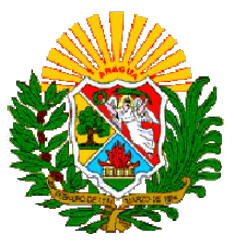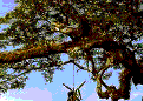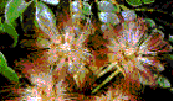Antecedentes - Antecedents
Bandera - Flag
Escudo de Armas - Coat of Arm
Himno - Anthem
Otros Emblemas Peculiares - Others Peculiars Emblems
Municipios - Municipalities
Antecedentes
El Estado Aragua está ubicado en el Centro Norte de Venezuela y limita al Norte con el Mar Caribe; al Sur con el estado Guárico; al Este con el estado Miranda y el Distrito Capital, y al Oeste con el estado Carabobo. Aragua es una voz aborigen de origen Cumanagoto (Caribe) con la que se designa al árbol llamado Chaguaramo: una palma ornamental de tronco hinchado. La capital del estado es la ciudad de Maracay que debe su nombre al Cacique Maracaya, jefe de la tribu que habitó antiguamente la región y fue fundada en 1697 por el Conquistador Andrés Pérez Almarza. Está conformado por los municipios Bolívar, Camatagua, Francisco Linares Alcántara, Girardot, José Félix Rivas, José Ángel Lamas, José Rafaél Revenga, Libertador, Mario Briceño Iragorry, Ocumare de la Costa, San Casimiro, San Sebastián, Santiago Mariño, Santos Michelena, Sucre, Tovar, Urdaneta y Zamora.
Fuentes: Portal Aldea Educativa, www.aldeaeducativa.com/
Aragua State is located on the Center North of Venezuela and limits to the North with Caribbean Sea; to the South with Guárico State; to the East with Miranda State and Capital District, and to the West with Carabobo State.Aragua is a voice with Cumanagoto' (Caribbean) origin and with it is designed a tree called Chaguaramo: an ornamental palm with swollen trunk.The capital of the State is the city of Maracay that receives its name from Cacique Maracaya, chief of the tribe which inhabited formerly the region and was founded on 1697 by Conqueror Andrés Perez Almarza. It's conformed by the municipalities Bolívar, Camatagua, Francisco Linares Alcántara, Girardot, José Félix Rivas, José Ángel Lamas, José Rafaél Revenga, Libertador, Mario Briceño Iragorry, Ocumare de la Costa, San Casimiro, San Sebastián, Santiago Mariño, Santos Michelena, Sucre, Tovar, Urdaneta and Zamora.
Sources: Web Site Aldea Educativa,
www.aldeaeducativa.com/
La Bandera
Atributos y Semiología
Consta de un paño de proporción vexilológica aproximada 2:3; esto es, cuadrado y medio de largo dividido en aspa o sotuer del que se derivan cuatro secciones triangulares: la superior e inferior de color rojo y amarillas la de los laterales. Al centro aparece el Escudo de Armas del Estado en todos sus atributos heráldicos. El amarillo simboliza el Sol tropical que caracteriza al estado e igualmente la Nobleza y la Caridad, virtudes que forman parte de la manera de ser de sus nativos. El Rojo simboliza la Fortaleza, el Valor, la Fidelidad, la Alegría y el Honor que acrisolan la identidad del aragüeño e igualmente recuerda los próceres que surgieron en Aragua y que derramaron su sangre sobre su suelo y el resto del territorio nacional a favor de la Independencia de Venezuela.
Reseña Histórica
En el transcurso del año 1991 y a instancias del Señor Carlos Tablante Hidalgo, Gobernador del Estado Aragua, se dieron inicio a las diligencias para crear una bandera regional y a tal efecto se solicitó la colaboración del Profesor Oldman Botello, Cronista de la Ciudad de Maracay, capital del Estado y de Villa de Cura, otra de sus poblaciones importantes, quien sugirió una bandera en la que predominasen los colores Amarillo y Rojo tomando como premisa la semiología antes indicada con base en su connotación heráldica. El 16 de Enero de 1992 y por disposición del Ejecutivo Regional, se promovió un concurso para determinar el diseño de a nueva bandera al que concurrieron unas trescientas personas, muchas de ellas estudiantes. Luego de considerar los diseños presentados, el jurado calificador integrado por el Profesor Botello, la Profesora Luisa Teresa Lanz de León, Secretaria de Educación y Asistencia Social, y el Profesor Enrique Salas Dugarte, Presidente de la Sociedad Bolivariana del Estado Aragua, seleccionó el 17 de Febrero de 1992 un proyecto presentado por la Licenciada Inés María Valverde Pérez, que una vez remitido a la Asamblea Legislativa del Estado, fue aprobado el 20 de Octubre siguiente cuando se proclamó la "Ley de la Bandera del Estado Aragua"
Fuentes: "Símbolos del Estado Aragua", Prof. Oldman Botello.
The Flag
Attributes and Semiology
Consist in a field with approximate ratio 2:3; this is, square and half of length divided per saltire generating four triangular sections: the upper and lower are red, whilst the flanques are yellow. The Araguenian Coat of Arms is emplaced on its center in all its heraldic attributes. The yellow symbolizes the tropical sun, which characterizes the state and equally the Nobility and the Charity, virtues that are part of the personality of its native ones. The red symbolizes the Strength, the Value, the Fidelity, the Happiness and the Honor that purify the araguenian identity and remembers equally, the heroes which arose in Aragua and that spilled their blood on its floor and on the rest of the national territory, in favor of the Independence of Venezuela.
Historical Synthesis
In the course of the year 1991 and by instances of Mr. Carlos Tablante Hidalgo, Governor of the State, was given beginning to the diligences for the creation of a regional flag and for that purpose was requested the collaboration of the Professor Oldman Botello, Chronicler of the City of Maracay and of Villa de Cura, another of its important populations, who suggested a flag in which prevails the colors Yellow and Red taking as premise for that the semiology before mentioned with base in its heraldic connotation. On January 16th, 1992 and for disposition of the Regional Executive, a concourse was promoted to determine the design of the new flag to the one that some three hundred people converged, many of them students. After considering the presented designs, the qualifier jury integrated by the Professor Botello, the Professor Luisa Teresa Lanz de León, Secretary of Education and Social Assistance of the Aragua State and the Professor Enrique Salas Dugarte, President of the Bolivarian Society of the State, selected on February 17th, 1992, a project presented by the Licentiate Inés María Valverde Pérez that once remitted to the Legislative Assembly, it was approved following October 20th when was proclaimed the "Law of the Flag of the Aragua State"
Sources: "Símbolos del Estado Aragua" ("Symbols of Aragua State"), Prof. Oldman Botello.
Escudo de Armas
- Atributos
El Escudo de Armas aragüeño consiste en un contorno con forma de tarja filerado de plata, tajado y medio tronchado. El Cuartel Siniestro del Jefe esmaltado en Gules (rojo) presenta una mujer rubia vestida y alada de plata que sujeta con la diestra una corona de laurel y con la siniestra una rama de palma. El Cuartel Diestro esmaltado en Oro (amarillo) muestra un árbol al natural terrasado de Sínople (verde). El Cuartel de la Punta esmaltado en Celeste (variación del Azur heráldico o azul) carga una casa colonial terrasada en Sínople (verde) y flamada (incendiada) en Gules (rojo). Como ornamentos exteriores el blasón presenta un sol naciente del Jefe en cuyo disco aparece la palabra "ARAGUA" inscrita en letras góticas capitales de Gules (rojo) como timbre y como sostenes una rama de café frutado a la diestra y otra de caña a la siniestra unidas bajo la punta mediante un gallardete de Oro (amarillo) donde aparecen como divisas las efemérides "FEBRERO DE 1814" a la diestra y "MARZO DE 1814" a la siniestra.
- Semiología
El Primer Cuartel muestra una representación de la antigua diosa griega de la Victoria que alude a la batalla que se libró en la población del mismo nombre el 12 de Febrero de 1814, donde jóvenes estudiantes y seminaristas de la Universidad de Caracas lucharon conjuntamente con las tropas patriotas que bajo el mando del General José Félix Ribas, uno de los más valientes próceres de nuestra guerra de independencia, triunfaron sobre el ejército realista bajo la conducción del Coronel español Francisco Tomás Morales. El Segundo Cuartel presenta una representación del así llamado "Samán de Güere": árbol histórico admirado por el famoso naturalista alemán barón Alejandro de Humboldt y su amigo, el Botánico francés Aimée Bonpland durante su visita a Venezuela en 1800, calculando que para entonces la planta tenía cerca de 1000 años de antigüedad. Se dice también que tiempo después El Libertador Simón Bolívar reposó bajo su fronda mientras estuvo en campaña y desde entonces constituye emblema ecológico del estado, señalando además la inagotable fertilidad de la tierra aragüeña. El Tercer Cuartel muestra una semblanza de la Casa Histórica llamada "El Ingenio Bolívar" ubicada en la población de San Mateo y propiedad de la familia de El Libertador que fue acondicionada como bastión de los patriotas durante la guerra de la Independencia: lugar donde ofrendó su vida heroicamente el Coronel neogranadino Antonio Ricaurte al volar el polvorín justo cuando las tropas realistas tomaban la casa el 25 de Marzo de 1814. El sol naciente constituye reafirmación de la identidad regional. Las ramas de café y de caña recuerdan dos de los principales productos agrícolas de la región, mientras que las efemérides aluden respectivamente a los sucesos gloriosos de "La Victoria" y "San Mateo", anteriormente mencionados.
- Reseña Histórica
Este símbolo aragüeño, cuyo origen fue el de Sello del Estado a partir de la octava década del siglo XIX, fue decretado como Escudo de Armas en 1905 y ratificado en 1926.
- Fuentes: "Los Símbolos Sagrados de la Nación Venezolana", Francisco Alejandro Vargas, Editorial Centauro, Caracas - Venezuela, 1981.
Coat of Arms
- Attributes
The Araguenian Coat of Arms consists of a compound contour with form of tally filleted in Argent (silver), divided per bend, the dexter per bend sinister. The Sinister Quarter of the Chief enameled in Gules (red) presents a blond woman dressed and winged of silver that holds with her right hand a laurel crown and with her left-hand a palm branch. The Dexter Quarter enameled in Or (yellow) shows a tree in its colors terraced in Vert (green). The Quarter of the Base in Sky-Blue (variation of the heraldical Azure or blue) charges a colonial house terraced in Vert (green) and fired in Gules (red). As external ornaments the blazon presents a sun rising from the Chief in whose disc appears the word "ARAGUA" inscribed in capital gothic letters of Gules (red) as crest and as supports a branch of fruited coffee to the dexter and another one of cane to the sinister jointed under the Base by means of a pennant in Or (yellow) where appear as mottoes the ephemeris "FEBRERO DE 1814" (February of 1814) to the dexter and "MARZO DE 1814" (March of 1814) to the sinister.
- Semiology.
The First Quarter shows a representation of the ancient Greek goddess of the Victory which alludes to the battle which got rid in the town with the same name, "La Victoria" (The Victory) on February 12th, 1814, where young students and seminarians of the University of Caracas fought jointly with the Patriot Troops under the command of General José Félix Ribas, one of the most bravest heroes of the Venezuelan Independence War, and won over the royalist army under the conduction of the Spaniard Colonel Francisco Tomás Morales. The Second Quarter presents a representation of the so-called "Samán de Güere" (Pitecellobium saman Jacq. Benth): historical tree admired by the famous German Naturalist Baron Alexander von Humboldt and his friend, the French Botanic Aimee Bonpland during their visit to Venezuela on 1800, calculating that then the plant was about 1.000 years old. It's says too that time after El Libertador Simon Bolivar rested under its frond when he was on campaign and since these times until now, it constitutes an ecological emblem of the State, representing in addition the inexhaustible fertility of the Araguenian ground. The Third Quarter shows a semblance of the Historical House called "El Ingenio Bolívar" ("The Bolivar's Sugar Cane Farm and Mill") located in the town of San Mateo and property of El Libertador's family which was conditioned like Patriots' bastion during the Venezuelan Independence War: place where surrendered heroically his life the New Grenadine (Colombian) Colonel Antonio Ricaurte firing the Gun Powder deposits when the royalist troops took the house on March 25th, 1814. The rising sun constitutes reaffirmation of the regional identity. The cane and coffee branches remember two of main agricultural products of the region, whereas the ephemeris respectively alludes to the glorious events of "La Victoria" and "San Mateo", previously mentioned.
- Historical Synthesis:
This Araguenian symbol, whose origin was as Seal of the State since the eighth decade of XIX Century, was decreed Coat of Arms on 1905 and ratified on 1926.
- Sources: "Los Símbolos Sagrados de la Nación Venezolana" ("Sacred Symbols of the Venezuelan Nation"), Francisco Alejandro Vargas, Editorial Centauro, Caracas - Venezuela, 1981.
Himno Regional - Regional Anthem
El Himno del estado Aragua fue decretado en 1906, modificado en 1909 y ratificado en 1929. La modificación consistió en la supresión de sus dos últimos versos debido a que se consideraban una alabanza hacia el depuesto y antiguo presidente Cipriano Castro (1908) que alcanzó en 1902 una importante triunfo militar en La Victoria contra un ejército revolucionario que casi duplicaba sus fuerzas. Cipriano Castro era nativo del estado andino del Táchira. La letra del Himno fue escrita por el Poeta Ramón F. Bastidas y su música fue compuesta por el Profesor Manuel M. Betancourt. La música es casi una sutil variación de La Marsellesa, el Himno nacional francés.
The Anthem of the Aragua State was decreed on 1906, modified on 1909 and ratified on 1926. The modification consisted in suppressing the two last verses because they were considered laudatory towards the overthrown former president of the Republic Cipriano Castro (1908), who achieved on 1902 an important military triumph in La Victoria against a revolutionary army which almost duplicated his forces. Cipriano Castro was native of the Andean state of Táchira. Lyrics was wrotten by Poet Ramón F. Bastidas and the music was composed by Professor Manuel M. Betancourt. Music is almost like a subtle variation of The Marseillais, French national anthem.
CORO
- Otros Emblemas
Al momento de redactar esta ficha no se dispone de datos oficiales referentes al ave emblemática del estado.
Árbol Emblemático: El Samán
El Samán (Pithecellobium saman), conocido como "raintree" en inglés, "mono-vaina" en hawaiano y mimosa en Filipinas es un árbol de crecimiento rápido oriundo de América Central y el Norte de la América del Sur. Naturalizado en muchos países especialmente tropicales, es sumamente apreciado como cortina para los ganados y como fuente de madera para tallas y muebles.
- Fuentes: Artículo del Sr. Roger G. Skolmen. www.bibliotecasvirtuales.org.ve/index_aragua.htm
Bolivar, Camatagua, Francisco Linares Alcántara, Gorardot, José Angel Lamas, José Félix Ribas,
José Rafael Revenga, Libertador, Mario Briceño Iragorry, Ocumare de la Costa de Oro, San Casimiro.
Material suministrado por la Dirección de Relaciones
Públicas del estado Amazonas,
Octubre 2003.
Antecedents
Material provided by the Direction of Public Affairs of
Amazonas State Government,
October 2003


En el libro que guarda la fama
tendrá nuestro nombre soberbio
blasón; el valor, nuestro hermoso
oriflama y el único escudo
será el corazón.
I
Nuestras armas por siempre
triunfales humillaron al fiero
español, del clarín a las voces
marciales que oyó en sus montañas
la tierra del sol.
II
Nuestro pueblo vibro de coraje
cuando esclava la patria gimió,
como ruge, del yugo al ultraje
ira potente soberbio el león.
III
En el campo sangriento de Marte
libertad a la patria ofrendo,
la proeza inmortal de Ricaurte
que en tierra aragüeña
su Olimpo encontró.
IV
Coronó nuestras cumbres de gloria
cuando Ribas la espada blandió,
y a su homérico afán la
victoria con sangre opresora
Sus campos regó.
Actualización: Octubre 2003
RJArt'2003


Municipios - Municipalities
VOLVER / BACK